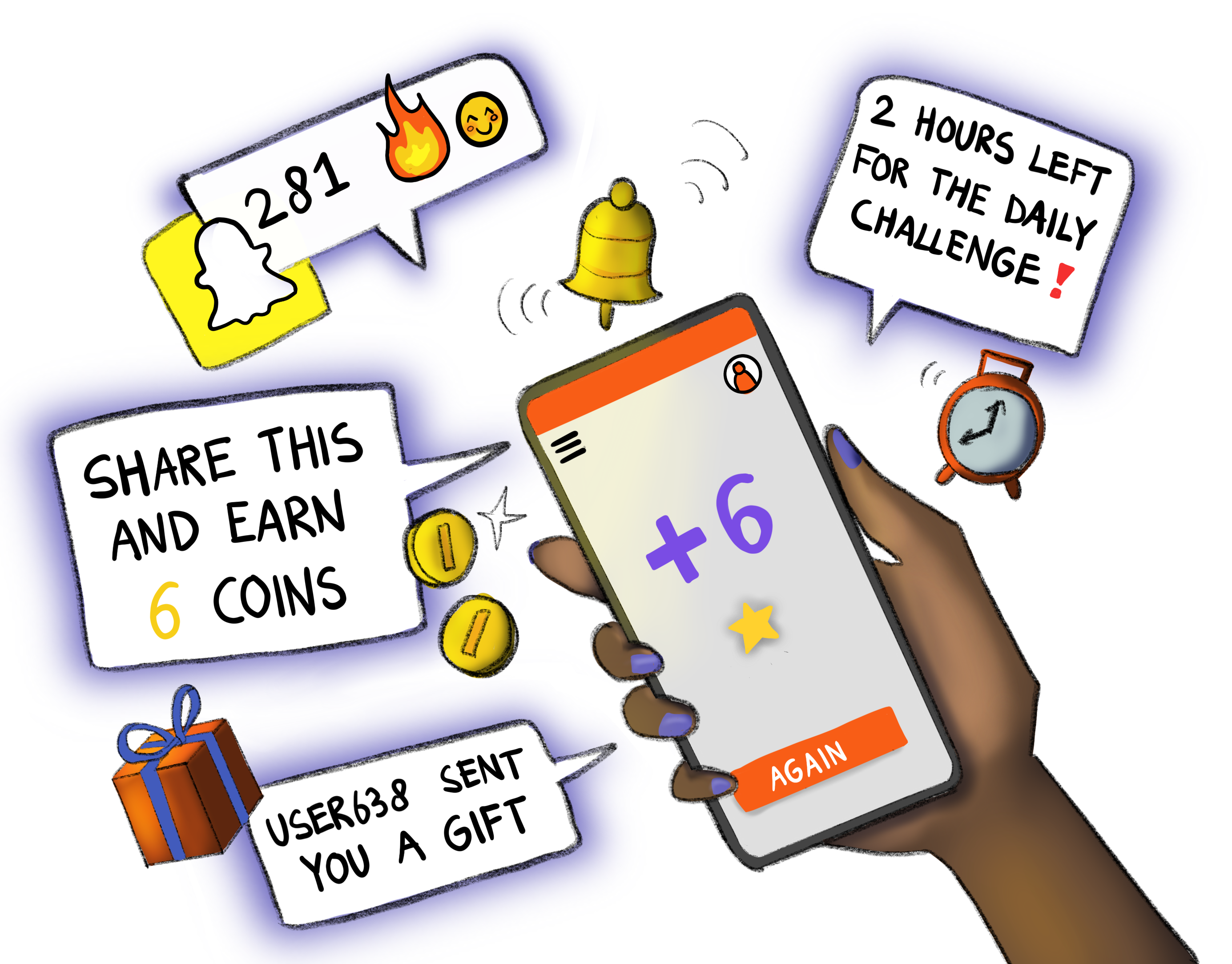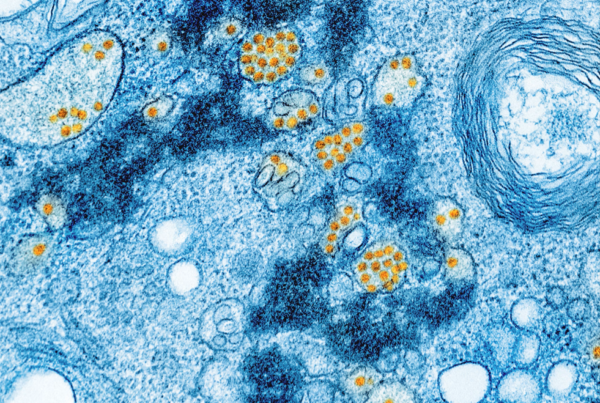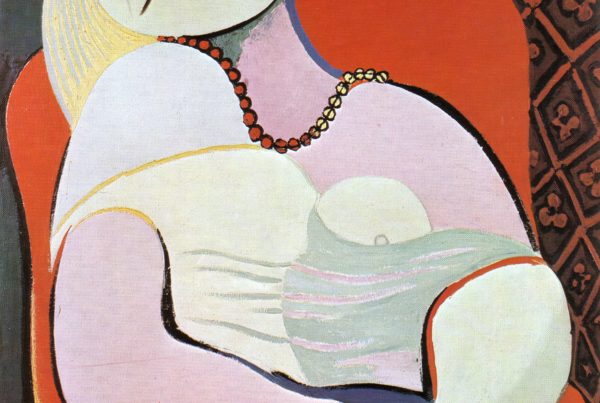
Social media platforms such as Snapchat employ techniques known as dark patterns to influence user behaviour. What are they and how do they pose a potential threat to our well-being?
Social media platforms such as Snapchat employ techniques known as dark patterns to influence user behaviour. What are they and how do they pose a potential threat to our well-being?

Illustration by Chitra Mohanlal

Illustration by Chitra Mohanlal
What are Dark Social Media Choice Architectures?
A dark choice architecture is a specific design consisting of dark patterns in online platforms, which can be considered deceptive as they push the user into doing something that they would not normally do by playing on psychological vulnerabilities, potentially causing harm to the user (Mathur et al., 2021). This could be for example, buying something that they would not have bought in absence of the dark pattern, or spending more time than intended on a specific platform. They have been considered to manipulate behaviour by playing on cognitive biases without users realising (Waldman, 2020). Social media users should become more aware of these dark patterns, as they may be the reason why users often find themselves spending more time on applications than they intend to, which can have a negative effect on well-being (Mastrodicasa, 2013).
The dark choice architecture this article will focus on is the “Forced Action” dark pattern. This dark pattern forces users to perform a certain action, to maintain the same functionality or specific aspect of a platform (Gray et al., 2018). This can be done through methods known as “Social Pyramid”, where users have to recruit other friends to gain benefits, “Privacy Zuchering”, where users are forced to share more information than the intend, and Gamification, where aspects of a platform are relatable to a game wherein repetitive actions are performed to achieve a certain aspect/feature of the platform. Forced Actions can be found on social media applications such as Facebook, Instagram, and Snapchat.
A specific example of Forced Action is “Snap Streaks” on the social media application Snapchat, which Waldman (2020) considers as a form of gamification. Snap Streaks, which appear on the user interface next to a friend’s name, consist of a number which indicates how many consecutive days each friend has exchanged an image each, and is usually accompanied by a colourful emoji (Lorenz, 2019). The reason that this can be considered part of forced action through gamification, is because it assigns a score to the relationship that you have with a friend on this platform. Users will then be incentivised to open the app every day, to send at least one message to maintain their Snap Streak. In line with what Marthur et al., (2021), defines as a dark pattern, this essentially coerces the user to perform an action they would not normally perform.
“as the streak is lost if both users don’t send at least one photo per day, so the goal of this feature is to get the user to open the application every day, with some users sending blank photos just to maintain a streak”
Psychology of Design
The Forced Actions through the gamification of Snapchat, an application which is primarily used for sending photos to friends, has implications which could be considered dark. At first glance, Snapchat streaks may just come across as a fun way to interact with friends. However, as the streak is lost if both users don’t send at least one photo per day, it is fair to say that the goal of this feature is to get the user to open the application every day, especially considering some users send blank photos just to maintain a streak (Hristova et al., 2020). This makes the feature dark, as it is an attempt to manipulate behaviour to increase the usage of the application (Marthur at al., 2021). Snapchat also assigns each user with a score, which is based on how much the user engages with the app through messaging, viewing/posting stories and watching reels (Parsons, 2021). This can again be considered part of the Snapchat gamification and can be considered dark as it pressures the user to engage in the application to maintain a certain status.
Snapchat streaks and scores seem to be effective in maintaining an active user base. In a qualitative study conducted by Weinstein (2018), adolescents noted that this was an essential feature which motivated them to continue to use the application. Participants noted that it gave them a form a form of social validation when a streak was maintained for a long time. However, some participants noted that it was “stressful” to have to keep up these streaks, and they felt obligated to have to maintain this. It was also cited as a source of anxiety, due to the stress and fear disappointing someone if the streak is no longer maintained. This shows the negative effects that this kind of pattern can have on well-being. Griffiths (2018) also discussed habitual social media use and notes how the introduction of Snapchat streaks has been extremely effective in keeping users psychologically invested. They may hold the logic that if they do not continue to use the application to maintain their streak, all the previous time they spent on the application was just a waste. This can in turn promote habitual use, which is again another negative effect on the welfare of the user, contributing further to the darkness of this pattern.
As stated, another feature on Snapchat that utilises gamification is each individual users scores. These scores are visible to a user’s friends, and can therefore enable social comparison, like how people compare scores on Freemium games (Dillon, 2020; Montag et al., 2019). There have been numerous studies which examine the effects of social comparison on social media. Many of these studies have found that social comparison on social media can have a negative impact on well-being (Choi & Kim 2020; de Vries et al., 2017; Yang 2016). Thus, if this pattern promotes social comparison, it could also be something that negatively impacts the mental health of the users. Griffiths (2018) discusses how social competition also contributes to habitual use of social media and discusses this in terms of competing with other users, and refers to Facebook likes, as well as users also competing with themselves. Although there is little research of this in relation to scores on Snapchat, it could be argued that users do the same here. Similar to Facebook likes, Snapchat scores are visible to other users, so they may be compelled to habitually use the application to increase their score.
“social comparison on social media can have a negative impact on well-being”
Tech4Good – Proposed Solution
To reduce the habitual use of Snapchat, the gamified aspects of the platform could be altered. In terms of streaks, there have been calls to remove this feature completely (BBC News, 2019), however, this is something that Snapchat has declined. Alternatively, the streaks could be less visually prominent. For example, instead of placing them next to the friend’s name, they could be accessed through clicking on the user’s profile and then clicking a specific section which shows if there is a streak. This could reduce the social pressure, like how the prominence of “ticks” on WhatsApp pressures the user to respond to messages (Montag et al., 2019). Snapchat Scores, which could promote social comparison, also pose as a potential factor which forces users to return to the application habitually and have a possible negative effect on mental health.
All in all, a proposed solution for this would be to perhaps remove the visibility of friend’s scores. This would reduce the possibility to compare one’s score to someone else’s without explicitly asking the person what their score is. To further investigate social comparison through social media, there have been studies on Instagram which have focussed on removing the visibility of likes, both on one’s own posts and other people’s posts (Prichard, 2021; Wallace and Buil, 2021). Generally, these studies have found that users are in favour of removing the visibility of likes, and that it reduces the observed negative effects on well-being that Instagram can have – which are commonly considered as a product of social comparison. Although there have been no direct studies on Snapchat regarding hiding Snapchat streaks and scores, parallels can be drawn in that it could also reduce the negative effects and habitual use of this platform. Thus, future research could employ a similar design in order to examine if those who have reduced visibility of streaks and scores on Snapchat report higher well-being and less habitual use than those who use the platform as it currently is. This would provide a more substantial and empirically based argument for these dark patterns to be addressed. <<
References
– BBC News. (2019, March 19). Snapchat under scrutiny from MPs over “addictive” streaks. https://www.bbc.com/news/technology-47623626
– Choi, S., & Kim, E.-M. (2020). Between Instagram browsing and subjective well-being: Social comparison or emotional contagion? Media Psychology, 1–25.
– de Vries, D. A., Möller, A. M., Wieringa, M. S., Eigenraam, A. W., & Hamelink, K. (2017). Social Comparison as the Thief of Joy: Emotional Consequences of Viewing Strangers’ Instagram Posts. Media Psychology, 21(2), 222–245.
– Gray, C. M., Kou, Y., Battles, B., Hoggatt, J., & Toombs, A. L. (2018). The Dark (Patterns) Side of UX Design. Proceedings of the 2018 CHI Conference on Human Factors in Computing Systems. Published.
– Hristova, D., Dumit, J., Lieberoth, A., & Slunecko, T. (2020). Snapchat streaks: How adolescents metagame gamification in social media. GamiFIN Conference. Published. http://ceur-ws.org/Vol-2637/paper13.pdf
– Lorenz, T. (2019, July 24). Teens explain the world of Snapchat’s addictive streaks, where friendships live or die. Business Insider. https://www.businessinsider.com/teens-explain-snapchat-streaks-why-theyre-so-addictive-and-important-to-friendships-2017-4?international=true&r=US&IR=T
– Mastrodicasa, J., & Metellus, P. (2013). The Impact of Social Media on College Students. Journal of College and Character, 14(1), 21–30.
– Mathur, A., Kshirsagar, M., & Mayer, J. (2021). What Makes a Dark Pattern. . . Dark? Proceedings of the 2021 CHI Conference on Human Factors in Computing Systems. Published.
– Montag, C., Lachmann, B., Herrlich, M., & Zweig, K. (2019). Addictive Features of Social Media/Messenger Platforms and Freemium Games against the Background of Psychological and Economic Theories. International Journal of Environmental Research and Public Health, 16(14), 2612.
– Parsons, J. (2021, February 19). How does Snapchat score work and how to increase my Snapchat score. Metro. https://metro.co.uk/2019/07/17/snapchat-score-work-increase-snapchat-score-10383254/
– Prichard, I., O’Toole, S., Wu, Y., Harford, J., & Tiggemann, M. (2021). No likes, no problem? Users’ reactions to the removal of Instagram number of likes on other people’s posts and links to body image. Body Image, 38, 72–79.
– Waldman, A. E. (2020). Cognitive biases, dark patterns, and the ‘privacy paradox.’ Current Opinion in Psychology, 31, 105–109.
– Wallace, E., & Buil, I. (2021). Hiding Instagram Likes: Effects on negative affect and loneliness. Personality and Individual Differences, 170, 110509.
– Yang, C.-. (2016). Instagram Use, Loneliness, and Social Comparison Orientation: Interact and Browse on Social Media, But Don’t Compare. Cyberpsychology, Behavior, and Social Networking, 19(12), 703–708.
What are Dark Social Media Choice Architectures?
A dark choice architecture is a specific design consisting of dark patterns in online platforms, which can be considered deceptive as they push the user into doing something that they would not normally do by playing on psychological vulnerabilities, potentially causing harm to the user (Mathur et al., 2021). This could be for example, buying something that they would not have bought in absence of the dark pattern, or spending more time than intended on a specific platform. They have been considered to manipulate behaviour by playing on cognitive biases without users realising (Waldman, 2020). Social media users should become more aware of these dark patterns, as they may be the reason why users often find themselves spending more time on applications than they intend to, which can have a negative effect on well-being (Mastrodicasa, 2013).
The dark choice architecture this article will focus on is the “Forced Action” dark pattern. This dark pattern forces users to perform a certain action, to maintain the same functionality or specific aspect of a platform (Gray et al., 2018). This can be done through methods known as “Social Pyramid”, where users have to recruit other friends to gain benefits, “Privacy Zuchering”, where users are forced to share more information than the intend, and Gamification, where aspects of a platform are relatable to a game wherein repetitive actions are performed to achieve a certain aspect/feature of the platform. Forced Actions can be found on social media applications such as Facebook, Instagram, and Snapchat.
A specific example of Forced Action is “Snap Streaks” on the social media application Snapchat, which Waldman (2020) considers as a form of gamification. Snap Streaks, which appear on the user interface next to a friend’s name, consist of a number which indicates how many consecutive days each friend has exchanged an image each, and is usually accompanied by a colourful emoji (Lorenz, 2019). The reason that this can be considered part of forced action through gamification, is because it assigns a score to the relationship that you have with a friend on this platform. Users will then be incentivised to open the app every day, to send at least one message to maintain their Snap Streak. In line with what Marthur et al., (2021), defines as a dark pattern, this essentially coerces the user to perform an action they would not normally perform.
“as the streak is lost if both users don’t send at least one photo per day, so the goal of this feature is to get the user to open the application every day, with some users sending blank photos just to maintain a streak”
Psychology of Design
The Forced Actions through the gamification of Snapchat, an application which is primarily used for sending photos to friends, has implications which could be considered dark. At first glance, Snapchat streaks may just come across as a fun way to interact with friends. However, as the streak is lost if both users don’t send at least one photo per day, it is fair to say that the goal of this feature is to get the user to open the application every day, especially considering some users send blank photos just to maintain a streak (Hristova et al., 2020). This makes the feature dark, as it is an attempt to manipulate behaviour to increase the usage of the application (Marthur at al., 2021). Snapchat also assigns each user with a score, which is based on how much the user engages with the app through messaging, viewing/posting stories and watching reels (Parsons, 2021). This can again be considered part of the Snapchat gamification and can be considered dark as it pressures the user to engage in the application to maintain a certain status.
Snapchat streaks and scores seem to be effective in maintaining an active user base. In a qualitative study conducted by Weinstein (2018), adolescents noted that this was an essential feature which motivated them to continue to use the application. Participants noted that it gave them a form a form of social validation when a streak was maintained for a long time. However, some participants noted that it was “stressful” to have to keep up these streaks, and they felt obligated to have to maintain this. It was also cited as a source of anxiety, due to the stress and fear disappointing someone if the streak is no longer maintained. This shows the negative effects that this kind of pattern can have on well-being. Griffiths (2018) also discussed habitual social media use and notes how the introduction of Snapchat streaks has been extremely effective in keeping users psychologically invested. They may hold the logic that if they do not continue to use the application to maintain their streak, all the previous time they spent on the application was just a waste. This can in turn promote habitual use, which is again another negative effect on the welfare of the user, contributing further to the darkness of this pattern.
As stated, another feature on Snapchat that utilises gamification is each individual users scores. These scores are visible to a user’s friends, and can therefore enable social comparison, like how people compare scores on Freemium games (Dillon, 2020; Montag et al., 2019). There have been numerous studies which examine the effects of social comparison on social media. Many of these studies have found that social comparison on social media can have a negative impact on well-being (Choi & Kim 2020; de Vries et al., 2017; Yang 2016). Thus, if this pattern promotes social comparison, it could also be something that negatively impacts the mental health of the users. Griffiths (2018) discusses how social competition also contributes to habitual use of social media and discusses this in terms of competing with other users, and refers to Facebook likes, as well as users also competing with themselves. Although there is little research of this in relation to scores on Snapchat, it could be argued that users do the same here. Similar to Facebook likes, Snapchat scores are visible to other users, so they may be compelled to habitually use the application to increase their score.
“social comparison on social media can have a negative impact on well-being”
Tech4Good – Proposed Solution
To reduce the habitual use of Snapchat, the gamified aspects of the platform could be altered. In terms of streaks, there have been calls to remove this feature completely (BBC News, 2019), however, this is something that Snapchat has declined. Alternatively, the streaks could be less visually prominent. For example, instead of placing them next to the friend’s name, they could be accessed through clicking on the user’s profile and then clicking a specific section which shows if there is a streak. This could reduce the social pressure, like how the prominence of “ticks” on WhatsApp pressures the user to respond to messages (Montag et al., 2019). Snapchat Scores, which could promote social comparison, also pose as a potential factor which forces users to return to the application habitually and have a possible negative effect on mental health.
All in all, a proposed solution for this would be to perhaps remove the visibility of friend’s scores. This would reduce the possibility to compare one’s score to someone else’s without explicitly asking the person what their score is. To further investigate social comparison through social media, there have been studies on Instagram which have focussed on removing the visibility of likes, both on one’s own posts and other people’s posts (Prichard, 2021; Wallace and Buil, 2021). Generally, these studies have found that users are in favour of removing the visibility of likes, and that it reduces the observed negative effects on well-being that Instagram can have – which are commonly considered as a product of social comparison. Although there have been no direct studies on Snapchat regarding hiding Snapchat streaks and scores, parallels can be drawn in that it could also reduce the negative effects and habitual use of this platform. Thus, future research could employ a similar design in order to examine if those who have reduced visibility of streaks and scores on Snapchat report higher well-being and less habitual use than those who use the platform as it currently is. This would provide a more substantial and empirically based argument for these dark patterns to be addressed. <<



